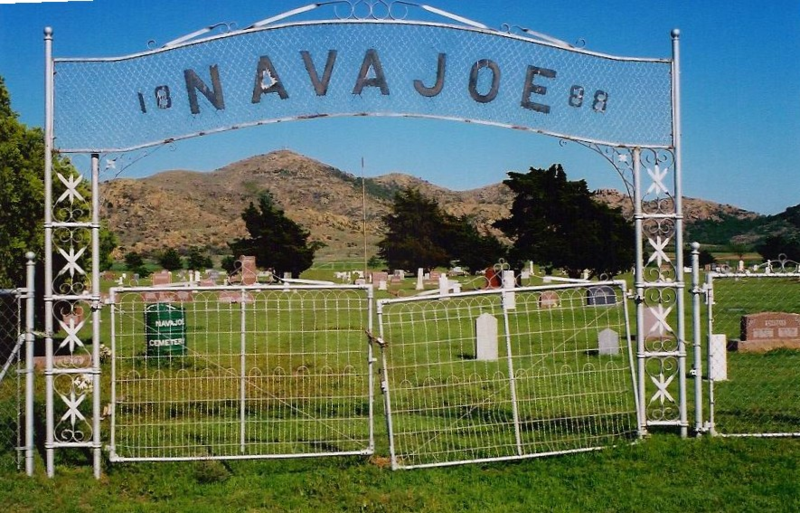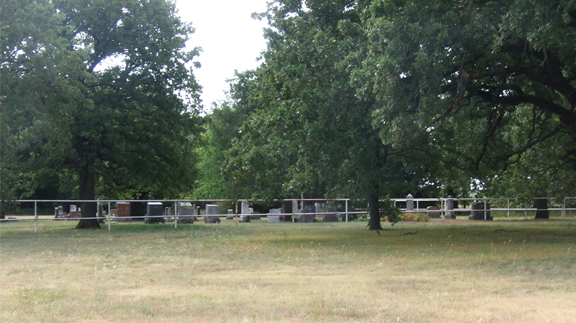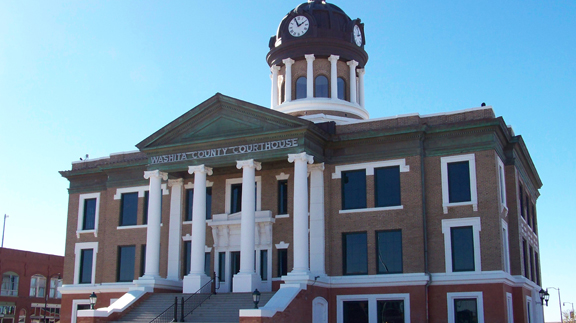Attractions
Oklahoma Facts & Trivia

Impress your friends with these 40 interesting tidbits of Oklahoma trivia.
- The first capital of Oklahoma was in Guthrie, but was moved later to Oklahoma City following a vote of the people.
- Turner Falls Park in Davis is the oldest park in Oklahoma. Many springs from the world famous Arbuckle Mountains form Honey Creek that cascades down a seventy-seven foot fall to a natural swimming pool making the majestic Turner Falls the largest waterfall in Oklahoma.
- Oklahoma City was settled by the historic Land Run of April 22, 1889. The city’s population grew to more than 10,000 in a single day. It is the largest city in the State of Oklahoma, with a metro population of more than 1.3 million.
- I-35, I-40 and I-44 all converge in Oklahoma City. The metropolitan area has 130+ miles of federal interstate and state highways.
- Oklahoma City averages more than 300 days of sunshine per year.
- The world’s first installed parking meter was in Oklahoma City, on July 16, 1935. Carl C. Magee, of Oklahoma City, Oklahoma, is generally credited with originating the parking meter. He filed for a patent for a “coin controlled parking meter” on May 13, 1935.
- The first shopping cart was invented and used in Oklahoma City at Standard Food Markets in 1937 by Sylvan Goldman.
- Boise City, Oklahoma was the only city in the United States to be bombed during World War II. On Monday night, July 5, 1943, at approximately 12:30 a.m., a B-17 Bomber based at Dalhart Army Air Base (50 miles to the south of Boise City) dropped six practice bombs on the sleeping town.
- Oklahoma’s state motto is Labor Omnia Vincit – Labor Conquers All Things.
- Bob Dunn a musician from Beggs invented the first electric guitar 1935.
- Oklahoma City is equal distant from Los Angeles and New York, and within 500 miles of 71 million people.
- Phillip H. Sheridan, George A. Custer and William T. Sherman were the founders of the USA’s main artillery fort at Fort Sill.
- Choctaw is the oldest chartered town in Oklahoma. Choctaw gained status as a town in 1893.
- The Amateur Softball Association of America – a volunteer-driven, not-for-profit organization based in Oklahoma City, OK – was founded in 1933 and has evolved into the strongest softball organization in the country.
- A statue entitled “Hopes and Dreams,” in downtown Perry was created by local sculptor Bill Bennett and placed there on a massive granite pedestal as a Cherokee Strip Centennial memorial. The statue portrays an early-day couple coming to the newly opened western frontier.
- Clinton Riggs designed the YIELD sign. It was first used on a trial basis in Tulsa.
- Okmulgee owns the world record for largest pecan pie, pecan cookie, pecan brownie, and biggest ice cream and cookie party. Each June, Okmulgee rolls out the welcome mat to thousands of its closest friends as the annual Pecan Festival comes to town.
- The town of Beaver claims to be the Cow Chip Throwing Capital of the World. It is here that the World Championship Cow Chip Throw is held each April.
- Spiro Mounds, Oklahoma’s only archaeological park, is a 140-acre site encompassing 12 southern mounds that contain evidence of an Indian culture that occupied the site from 850 A.D. to 1450 A.D. The Mounds are considered one of the four most important prehistoric Indian sites east of the Rocky Mountains.
- Garth Brooks was born in Tulsa, Oklahoma and grew up in Yukon, Oklahoma.
- WKY Radio was the first radio station transmitting from west of the Mississippi River.
- Belle Starr one of the most famous women outlaws is buried in an isolated grave southwest of Porum, Oklahoma near the Eufuala Dam.
- In Guthrie nearly 20,000 lighters and “fire starters” are displayed at the National Lighter Museum. The nation’s only museum devoted to the collection of lighters.
- Oklahoma’s four mountain ranges include the Ouachitas, Arbuckles, Wichitas and the Kiamichis.
- Forest B. Lillie was a participant in the land run of 1889, and set up a tent for business as soon as shots were fired. Lillie’s Drug was the first drug store established in Guthrie. Lillie was issued the No. 1 license certificate when the new state of Oklahoma registered him as a practicing pharmacist.
- On the evening of March 25, 1948, a tornado roared through Tinker Air Force Base (AFB), Oklahoma, causing considerable damage, a few injuries, but no fatalities. However, the destruction could have been much worse. A few hours earlier Air Force Captain Robert C. Miller and Major Ernest J. Fawbush correctly predicted that atmospheric conditions were ripe for tornadoes in the vicinity of Tinker AFB. This first tornado forecast was instrumental in advancing the nation’s commitment to protecting the American public and military resources from the dangers caused by natural hazards.
- The slogan “Buckle of the Wheat Belt” designates Kingfisher. Kingfisher was the largest wheat market in America.
- Oklahoma is one of only two states whose capital cities name includes the state name. The other is Indianapolis, Indiana.
- Oklahoma’s state wildflower the Indian Blanket is red with yellow tips. It symbolizes the state’s scenic beauty as well as the its Indian heritage. The wildflower blooms in June and July.
- Oklahoma has more man-made lakes than any other state, with over one million surface acres of water.
Attractions
Oklahoma Ghost Towns – Navajoe

Southwestern Oklahoma is rich with history and has a beautiful, rugged landscape. A lesser known mountain range, the Navajo Mountains sits in eastern Jackson County, just to the north east of Altus.
There, at the base of those mountains, used to be the town of Navajoe. It’s easy to surmise that the town took its name from the nearby mountains. As a side note, from my research, it seems that the Navajo Mountains got their name because of a failed Navajo raid. According to folklore, the Navajos attempted to steal Comanche horses, and were annihilated by the Comanches. Legendary Comanche Chief Quanah Parker gave a detailed account of a similar failed Navajo raid in 1848 or 1849, against his village in Elk Creek just north of the mountains.
Approximately 40 years later, in 1886 when the area was still part of Greer County, Texas, two men named W.H. Acers and H.P. Dale opened a general store in the area. The next year, “Buckskin Joe” Works, a Texas land promoter, attended a Fourth of July picnic in the area. The celebration included settlers, cowboys, and several Comanches led by Quanah Parker.
That same year, the town received a post office designated as “Navajoe” to avoid confusion to Navajo, Ariz. Around the same time the Navajoe school opened, and a couple churches were founded.
Eventually the town was home to more than 200 families, and had a booming trade center, complete with grocery stores, hardware stores, saloons, a blacksmith, a dry goods store, a hotel, and a cotton gin. It was a regular frontier time.
Unfortunately, in 1902, the railroad eventually bypassed Navajoe, ensuring its demise, as most businesses moved – buildings and all. Less than two decades later the Navajoe School was consolidated with Friendship and other school districts. Now, all that remains of the town is a small cemetery at the foot of the mountains. A granite monument, which was fashioned in 1976, pays tribute to the old town.
Eventually, in the mid-1960s, Friendship and Warren schools consolidated. The new school, which graduated its first class in 1964 and is still active in Jackson County, is called Navajo.
Read more in the February 2020 issue of Oklahoma Farm & Ranch.
Sources
Wikipedia.com
RedDirtChronicles.com
Attractions
Sugden: Once a thriving community

by Judy Wade
Hundreds of villages and small towns almost disappear each year. Some just fade away with little to mark their existence. Others have left ghostly reminders, and a few cling tenaciously to life. Sugden, Oklahoma, joined the list in the mid-70s. Like most of these communities, several factors were involved in its decline.
In Sugden’s case, it failed to receive enough votes to become the county seat of Jefferson County, the town was often inaccessible when Beaver Creek was flooded and there was an inadequate fresh water supply. The Great Depression and the drought were also contributing factors.
The story began in 1873 when brothers J.D. and Calvin Suggs came to the area and entered the cattle business on a large scale along Beaver Creek and Cow Creek, including the site of present-day Waurika and Sugden and the surrounding area. They ran as many as 40,000 head of cattle each year as well as large herds of horses.
The brothers built a double log house on what is now the south edge of Waurika to serve as headquarters for their spread. Homesteaders were attracted to the area, and a general store called “Sugg’s Den” was built in the early 1890s. When a Post Office was built in 1893, the name of the community became Sugden. The town was located five miles south and one mile west of Waurika.
Businesses included a cotton gin, bank, hotel, a church that also served as the school, a blacksmith and two newspapers, the Sugden Leader and the Sugden Signal. Two general stores served the needs of the people, one owned by R.P. (Bob) Grogan, who also operated a general store in Benvanue, Texas, just across the Red River to the east. By 1910, there were 321 residents. Local farmers shipped cattle, hogs, wheat and cotton on the Chicago, Rock Island and Pacific Railroad that passed through the community.
These people were true pioneers in a time when making a living was tough, and the law was made by those willing to defend their rights. The six-shooter was often the defender of law and order. It was told that J. D. Suggs shot three rustlers who were rounding up a bunch of his cattle one morning before breakfast.
The Suggs brothers leased a large amount of land from the Comanche Indians. Quanah Parker and some of his tribe would come to Sugden in the autumn and camp. Their teepees could be seen in every direction. The Indians gathered and sold pecans, and the Suggs brothers gave them beef.
One of the Suggs brothers’ valued employees was Mort Mitchell, a well-respected Black man who herded cattle all over the region. He was a familiar figure in and around Waurika.
Calvin Suggs died in 1902. J.D. passed away in 1925. He was a multi-millionaire at the time of his death, having bought several other ranches.
By 1940, Sugden had only 171 residents. Because of the declining population, the Post Office was closed in 1955. The 2010 census showed 43 people still living in the community. Abandoned homes and barns can be sees scattered throughout the community, some reflecting an opulence of days gone by. Tombstones of former residents rest in the quiet shade of a well-tended cemetery.
The story of Sugden is one of adventure, excitement and hardship. It is the history of a people who wrested a living from the land when the state of Oklahoma was developing.
Sources:
Oklahoma Historical Society
Dyer, J.M., History of Jefferson County
This article originally appeared in the September 2018 issue of Oklahoma Farm & Ranch.
Attractions
Washita County Courthouse

By Staci Mauney
The Washita County Courthouse, located in New Cordell, Okla., has a colorful history that began long before statehood. Stories abound about the location, with local residents relating details of stolen court records ending in a gun fight, a mysterious fire and most recently, a movie filmed with A-list celebrities. The city of New Cordell, commonly known as Cordell, was established in 1897 when H. D. Young, a local merchant who set up shop one and a half miles from the present location, moved his general store and post office to the new site.
Throughout the years, the courthouse has been the scene of drama and suspense. In 1899, two local homesteaders and farmers, A. J. Johnson and James C. Harrel, donated land for the courthouse square and arranged for an election to have the county seat moved from Cloud Chief, Okla. Controversy surrounded the city as questions of legality arose after the election. Because Oklahoma was still a territory at the time, a county seat could only be established by Congress. The election was finally sanctioned by Congress in 1906. In the meantime, the original wood-frame courthouse was moved from Cloud Chief to the present location in 1900. According to local lore, a gun fight broke out when some impatient citizens moved the court records from Cloud Chief to Cordell in the middle of the night. Even now, residents recount how the county seat was “stolen.”
In 1902, construction began on a new, wood-frame, two-story courthouse to replace the courthouse brought over from Cloud Chief. In 1909, the building was destroyed by a suspicious fire, believed to be arson. Just three nights before hearings were scheduled for cases involving a variety of whiskey charges, cattle thefts and horse thefts, a fire broke out in one of the courtrooms. The arsonist was never caught.
Solomon Andrew Layton and his firm, Donathan, Moore, Layton, Wemyss & Smith, designed the building in both 1902 and again in 1911 after the fire. Layton was also the architect for the Oklahoma State Capitol building in Oklahoma City. The current building, completed in 1913, was designed in the Classical Revival style.
A recent renovation of the interior of the courthouse began in 2013 and was completed just over two years later. This renovation began during the 100 year anniversary of the courthouse. According to local retail business owner and city council member, Terry Patton, the courthouse will last for another 100 years. One of the most striking features of the courthouse is the large, central dome with a four-sided clock that can be seen in all directions by those visiting downtown.
The Washita County Courthouse square became a major economic boon for both the city of Cordell and Washita County. Buildings sprang up around the courthouse square and surrounding area, including the city hall, an opera house, the Carnegie Public Library (now the Washita County Museum), the post office and the county jail.
The courthouse and its square continue to contribute to the economic stability of the area. Over the years, the area has seen businesses such as the Frisco Railroad set up there as well as factories. The downtown area now has more service industries than retail, although several small businesses remain around the square.
Patton knows firsthand the benefits of the courthouse square location, both for his business and for the city. He has owned Cordell TV, Appliance and Furniture, located on the square, for 27 years. After taking a class in heating and air at the area vo-tech, now the Western Technology Center, he received on-the-job training from a local businessman. At the end of his training, he was hired and eventually bought the business.
As a member of the Cordell city council for 11 years, Patton has seen tourists from across the United States taking pictures of the courthouse and eating at local restaurants. Because Cordell is the county seat, people come from all over the county to take care of business and contribute to the local economy.
“It’s a pleasant experience owning a retail business in a small town,” Patton says. “You know your customers by their first names.”
In 2010, filming of The Killer Inside Me, a crime drama set in the 1950s, took place around the courthouse square. On any given afternoon during filming, Casey Affleck, Jessica Alba, Kate Hudson and Simon Baker could be seen discussing the script with director Michael Winterbottom and producer Andrew Eaton in front of local businesses. Local residents who had been hired as extras milled about, waiting to be called for their scenes.
The courthouse square was chosen as one location for filming in Oklahoma because the historic appearance was just what was needed for the movie setting. Businesses repaired some of the facades prior to filming, and some businesses were given new names and new signage to fit with the 1950s setting.
The use of the courthouse square in the movie provided an opportunity for publicity for the city of Cordell. Media crews descended on Cordell, allowing the city – and the courthouse – to be the center of attention.
In 1984, the Washita County Courthouse was added to the National Registry of Historic Places, and the courthouse square district was added to the registry in 1999. Visitors and residents alike enjoy the benefits of the area as the iconic Washita County Courthouse is on display every day, with people coming from all over to get a glimpse of history.
**This story was originally published in the January 2016 issue of Oklahoma Farm & Ranch.
-

 Attractions8 years ago
Attractions8 years ago48 Hours in Atoka Remembered
-

 Country Lifestyle9 months ago
Country Lifestyle9 months agoJuly 2017 Profile: J.W. Hart
-

 Country Lifestyle9 years ago
Country Lifestyle9 years agoThe House a Treasure Built
-

 Country Lifestyle4 years ago
Country Lifestyle4 years agoThe Two Sides of Colten Jesse
-

 Outdoors7 years ago
Outdoors7 years agoGrazing Oklahoma: Honey Locust
-

 Equine8 years ago
Equine8 years agoUmbilical Hernia
-

 Outdoors5 years ago
Outdoors5 years agoPecan Production Information: Online Resources for Growers
-

 Farm & Ranch7 years ago
Farm & Ranch7 years agoHackberry (Celtis spp.)




